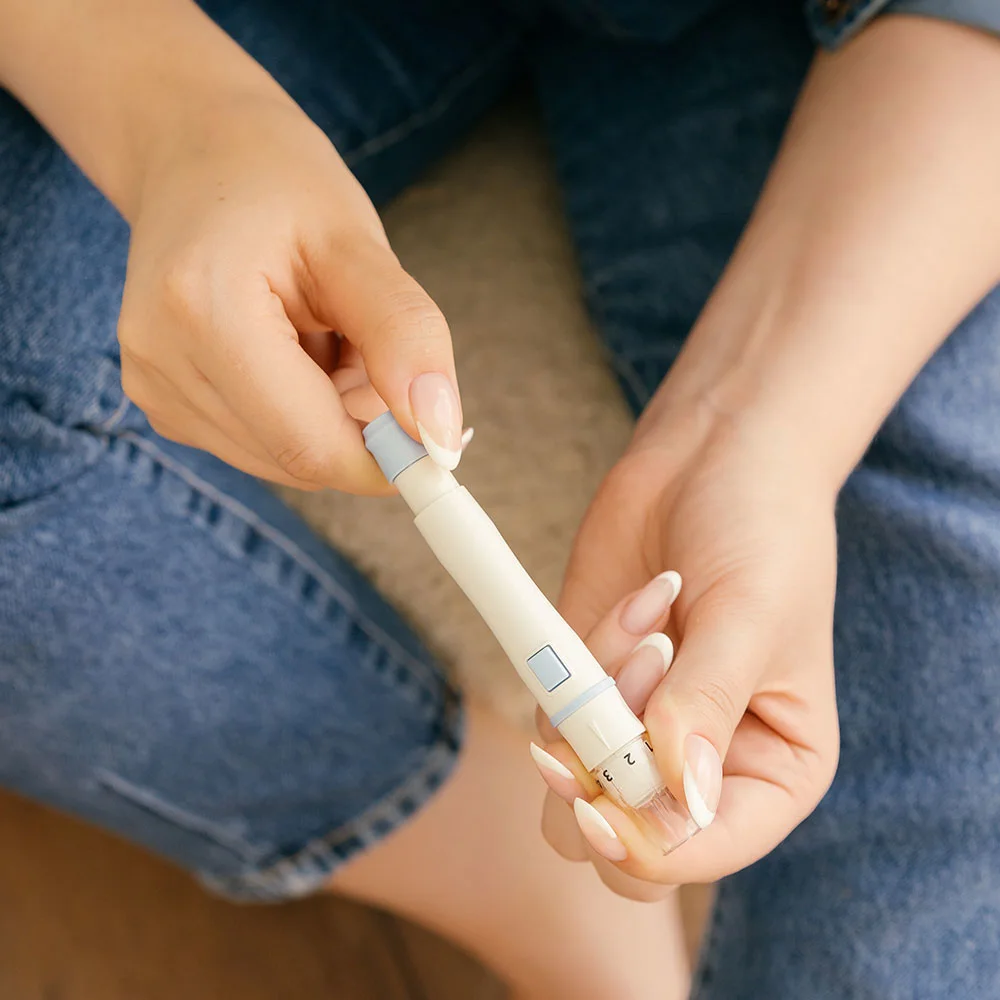Here's what we'll cover
Here's what we'll cover
Diabetes mellitus (aka diabetes) is one of the biggest epidemics in the world today. According to the Center for Disease Control and Prevention (CDC), it is the seventh leading cause of death in the United States (CDC, 2017). Type 1 diabetes (T1DM) accounts for approximately 5% of cases of diabetes in the United States, while approximately 90% of cases are type 2 diabetes (T2DM) (CDC, 2019). Gestational diabetes is a specific type of diabetes that occurs with pregnancy. Women with gestational diabetes are at higher risk of T2DM later in life. Aside from being a leading cause of death, type 1 and type 2 diabetes increase the risk of several other diseases and complications. Diabetes complications include:
Heart disease
Stroke
Heart failure
Chronic kidney disease that may lead to the need for dialysis and kidney transplants
Eye disease, including blindness
Nerve damage (diabetic neuropathy): This can lead to numbness and/or pain in the hands and feet, digestive problems, and sexual problems
Amputations (diabetes is the leading cause of amputations)
Infections, including urinary and skin infections
So if diabetes can lead to such poor outcomes, wouldn't it be good to be able to pick up on the early warning signs? Unfortunately, most diabetes symptoms don't appear until the disease is already advanced. But some things can tip you off that you may have—or be at risk for—diabetes.
Type 1 diabetes warning signs
T1DM is an autoimmune disease caused by the destruction of the cells in the pancreas (beta cells) that produce insulin. The result? An inability to produce insulin. Insulin is the hormone responsible for removing glucose (sugar) from the blood and getting into liver, muscle, and fat cells. When there is no insulin being produced, blood glucose levels rise, causing hyperglycemia (high blood sugar). Glucose is the primary type of sugar in the blood, so the terms "blood glucose" and "blood sugar" are often used to mean the same thing. T1DM occurs most commonly in children and was previously referred to as "juvenile diabetes" or "juvenile-onset diabetes," although it can also occur later in life. It most commonly appears at ages 4–6 and 10–14 and about 45% of people are diagnosed before age 10. The symptoms of T1DM vary slightly depending on the age of the person.
T1DM in older children and adolescents
Symptoms of T1DM can often progress very rapidly, so it's essential to seek medical attention early if you or someone you know have any of the common symptoms of diabetes. The most common symptoms of T1DM in children and adolescents are:
Extreme thirst (polydipsia)
Extreme hunger (polyphagia)
Frequent urination, including at night (polyuria)
Unexplained weight loss in spite of eating normally or even more than normally
Extreme fatigue
Diabetic ketoacidosis (DKA) is a potentially severe life-threatening complication of type 1 diabetes that is present in about 30% of children and adolescents at the time of diagnosis (Klingensmith, 2013). Although rare, it can also occur in type 2 diabetes.
DKA is caused by insufficient insulin once enough of the beta cells of the pancreas are destroyed. Under normal circumstances, insulin helps glucose get into specific cells in the body. When there is no insulin (or very little) present, glucose levels rise dramatically. High blood sugar levels cause people to urinate much more than usual and lose a lot of glucose in the urine. It also causes the body to burn large amounts of fat (fatty acids) for fuel.
In the process of burning all this fat, the body also produces something called ketone bodies or ketones. Ketones are partially burned fatty acids. The problem with ketones is that they are acidic. The result of these processes is severe dehydration and abnormal mineral levels due to the large amounts of urine, and blood that is too acidic, which is why it's called "diabetic ketoacidosis."
The symptoms of DKA are:
Extreme thirst (polydipsia)
Frequent urination, including at night (polyuria)
Abdominal pain
Nausea
Vomiting
Lethargy
Altered mental state (when severe), which can include coma
Death if severe and untreated
DKA requires emergency treatment with IV fluids and insulin as well as close monitoring and correction of the levels of certain minerals in the blood. If you or someone you know experiences these symptoms, seek out medical attention immediately.
T1DM in very young children and infants
Although rare, T1DM can appear very early in life. The signs in very young children and infants are more difficult to recognize because they can't express that they're thirsty and it's often difficult to determine how much they are urinating. Nevertheless, some things can be identified as warning signs, even in infants, including:
Decreased energy and activity
Irritability
Weight loss
Visible signs of dehydration, such as reduced tear production, sunken eyes, and dry mouth
These signs can also be caused by other things, like infections. It's essential to have them assessed as soon as possible by a healthcare provider.
T1DM in adults
Warning signs of T1DM in adults are similar to those in older children and adolescents. It's important to think of diabetes as a possibility so that it can be addressed and treated sooner rather than later. Adults can also have DKA at the time of diagnosis, which requires emergency medical treatment.
T2DM warning signs
Unlike T1DM, T2DM takes years to develop, and symptoms tend to be absent until the disease is advanced, and blood glucose levels are very high. T2DM is caused by the body's cells becoming resistant to the effects of insulin. Over time, insulin resistance causes blood sugar levels to rise. Eventually, the pancreas can get "burned out" and start producing less insulin as well. This slow process means you can go for years with T2DM and have no symptoms whatsoever. This is why it's important to get screened if you have risk factors such as a family history of type 2, high blood pressure, are older than 45, have polycystic ovary syndrome (PCOS), have a personal history of gestational diabetes, and are overweight or obese. Also, certain ethnic groups are at higher risk of developing type 2. The most common type 2 symptoms to watch out for are:
Extreme thirst (polydipsia)
Extreme hunger (polyphagia)
Frequent urination, including at night (polyuria)
Extreme fatigue
Blurry vision
Wounds that don't heal
Numbness and/or pain in your hands and feet (due to nerve damage)
Frequent and/or severe yeast infections
DKA is rare in T2DM, but another complication can occur called hyperosmolar hyperglycemic state (HHS). This happens when the glucose levels go very high, but there is enough insulin in the body to prevent the formation of many ketones. In HHS, the blood does not get acidic, but dehydration can be very severe, and coma and death can occur without treatment. HHS is also a medical emergency and is treated similarly to DKA although the dehydration is often even more severe.
Gestational diabetes warning signs
About 6% of pregnancies in the United States are complicated by gestational diabetes. During pregnancy, certain maternal hormones make the pregnant woman more insulin resistant. This happens to all women to some degree, but women who are susceptible can develop gestational diabetes.
The changes that lead to gestational diabetes are not enough to cause blood sugar levels to rise extremely high, and therefore, gestational diabetes generally does not cause any symptoms. Even though it does not cause symptoms, gestational diabetes can cause many complications for the mother and her child. The American Diabetes Association (ADA) recommends that all pregnant women be screened for gestational diabetes at 24–28 weeks of pregnancy (ADA, 2018).
Risk factors for gestational diabetes include:
Family history of T2DM
Personal history of prediabetes or previous gestational diabetes
Nonwhite race
Obesity
Women with a history of PCOS should be screened for diabetes after pregnancy because it is a risk factor for T2DM.
Diagnosis of diabetes
There are three main tests used to diagnose the different types of diabetes: fasting plasma glucose (fasting blood sugar), hemoglobin A1C (HbA1c), and oral glucose tolerance test (OGTT). All three can be used to diagnose T1DM and T2DM, but only the OGTT is used to diagnose gestational diabetes. The table below shows different cutoff values for T1DM and T2DM.

A random (non-fasting) blood sugar of 200 mg/dL or more can also be used to diagnose T1DM or T2DM if a person has symptoms of diabetes. Gestational diabetes is a bit more complicated to diagnose.
Ways to manage diabetes
Treatment for diabetes depends on the type. T1DM is always treated with insulin since none is being made by the body, and we can't live without it. Today, there are many types of insulin, and they can be given through traditional syringes, syringe pens, and insulin pumps.
The backbone of treatment for T2DM is lifestyle management and a drug called metformin. Lifestyle changes include a healthy diet high in fruits and vegetables, regular exercise, and weight loss. Other oral and injectable medications are available if lifestyle and metformin alone are not enough or if metformin cannot be taken for some reason. Some people with diabetes will also need to use insulin to treat their T2DM. This usually occurs after many years of having the disease or when blood sugar levels cannot be controlled through other means.
Gestational diabetes is generally managed with dietary changes and regular glucose checks. If this is not enough, the traditional medication for gestational diabetes is insulin. Some doctors also prescribe metformin for gestational diabetes, although this is considered an off-label treatment (it is not FDA-approved for this purpose).
DISCLAIMER
If you have any medical questions or concerns, please talk to your healthcare provider. The articles on Health Guide are underpinned by peer-reviewed research and information drawn from medical societies and governmental agencies. However, they are not a substitute for professional medical advice, diagnosis, or treatment.
American Diabetes Association. (2018). 2. Classification and Diagnosis of Diabetes: Standards of Medical Care in Diabetes—2018. Diabetes Care , 41 (Supplement 1). doi: 10.2337/dc18-S002. Retrieved from https://care.diabetesjournals.org/content/41/Supplement_1/S13
Centers for Disease Control and Prevention. (2017, March 17). FastStats - Leading Causes of Death. Retrieved from https://www.cdc.gov/nchs/fastats/leading-causes-of-death.htm
Centers for Disease Control and Prevention. (2019, August 6). Learn about Diabetes. Retrieved from https://www.cdc.gov/diabetes/basics/diabetes.html
Klingensmith, G. J., Tamborlane, W. V., Wood, J., Haller, M. J., Silverstein, J., Cengiz, E., et al. (2013). Diabetic Ketoacidosis at Diabetes Onset: Still an All Too Common Threat in Youth. The Journal of Pediatrics , 162 (2). doi: 10.1016/j.jpeds.2012.06.058. Retrieved from https://www.ncbi.nlm.nih.gov/pubmed/22901739










